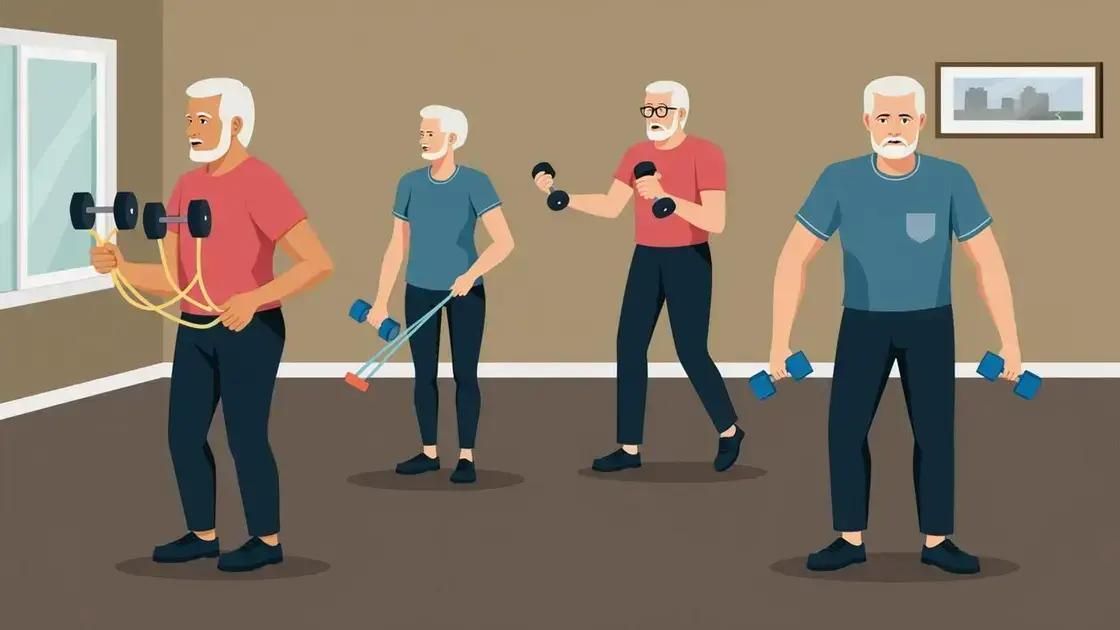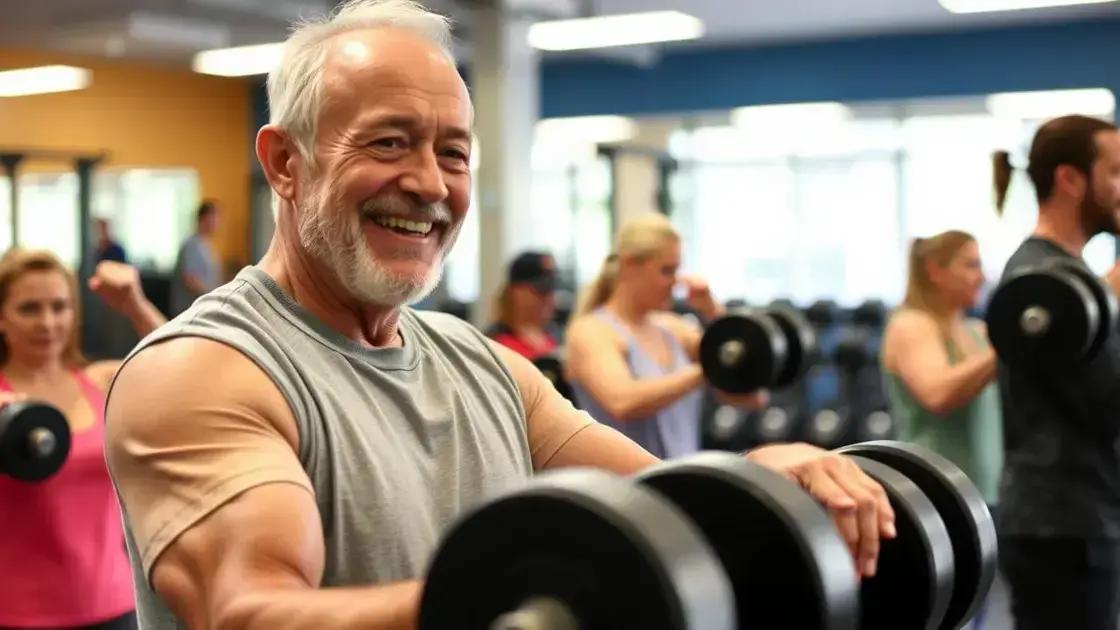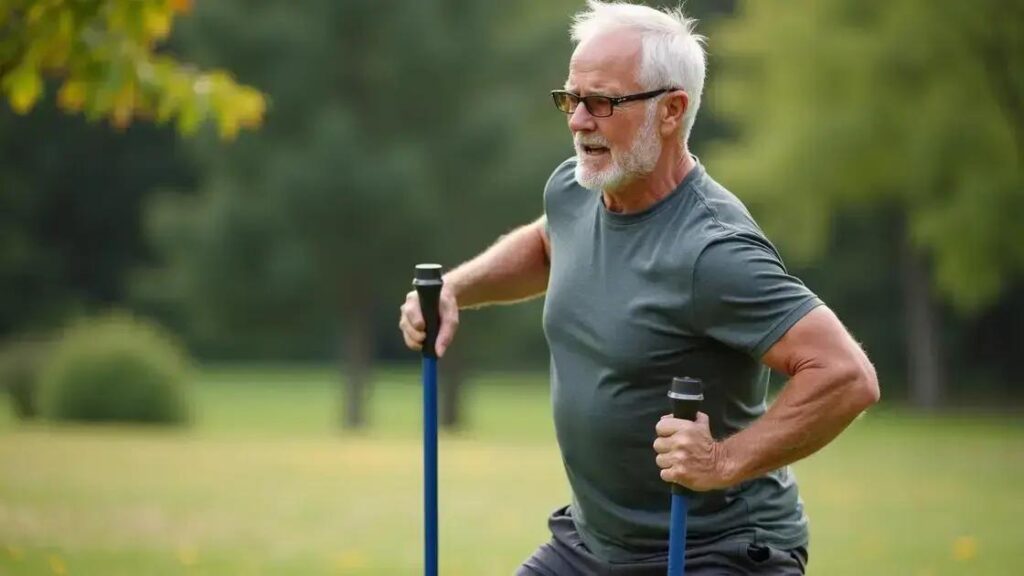The role of functional training for men over 50 is vital for improving overall health, mobility, and strength, helping them maintain an active lifestyle while reducing the risk of injury and joint pain.
Functional training plays a vital role for men over 50, promoting not only strength but also flexibility and balance. As men age, they often face challenges related to mobility and overall fitness. Incorporating functional training into a fitness regime can greatly enhance daily activities, making them more enjoyable and easier. In this article, we’ll delve into what functional training is, its numerous benefits, and practical ways to integrate it into your lifestyle.
Understanding Functional Training

Understanding Functional Training is crucial for men over 50. This type of training focuses on exercises that mimic real-life movements, helping you maintain independence and perform daily tasks more easily. Unlike traditional workouts that might isolate muscle groups, functional training engages multiple muscles and joints at once. This holistic approach enhances coordination, balance, and strength.
The Importance of Core Stability
In functional training, core stability is vital. A strong core helps with posture, improves balance, and reduces the risk of injuries. Activities such as squats, lunges, and planks not only strengthen the core but also improve overall body mechanics.
Examples of Functional Exercises
Functional exercises include movements like kettlebell swings, step-ups, and resistance band exercises. These movements help simulate everyday tasks—like lifting groceries or climbing stairs—making them practical and effective.
Adapting Functional Training for Age
For men over 50, it’s essential to adapt the intensity of functional training based on fitness levels. Start with lighter weights or body weight and gradually increase difficulty as strength improves. Always focus on form to prevent injury and maximize benefits.
Incorporating functional training into your routine can lead to better mobility, improved strength, and a healthier, more active lifestyle. It allows men over 50 to stay fit and engaged in daily activities.
Benefits of Functional Training for Older Men

Benefits of Functional Training for Older Men are numerous and impactful. First, this training style improves mobility. As men age, flexibility and movement can decrease. Functional training focuses on exercises that enhance full-body movements, promoting better range of motion.
Enhancing Strength and Balance
Another key benefit is improved strength and balance. Stronger muscles are essential for everyday tasks, like getting up from a chair or walking. Balance exercises in functional training can help prevent falls, a common concern for older adults.
Supporting Joint Health
Functional training also supports joint health. Using low-impact exercises minimizes stress on the joints while still building strength. This is crucial for older men who may experience joint pain or stiffness.
Boosting Overall Health and Well-Being
Additionally, regular functional training can boost overall health and well-being. It encourages physical activity, which is essential for heart health, weight management, and mental clarity. Older men who engage in these activities often report feeling more energetic and less stressed.
Incorporating functional training into a routine can lead to a more active, healthier lifestyle, allowing men over 50 to enjoy their daily lives to the fullest.
How to Incorporate Functional Training

How to Incorporate Functional Training into your routine can seem challenging, but it is easier than it looks. Begin by understanding your personal fitness level and goals. Assessing where you currently are will help you tailor functional workouts to fit your needs.
Start with Simple Movements
Start with basic movements that mimic daily tasks. Exercises such as squats, lunges, and push-ups are great for building a foundation. You can perform these exercises using just your body weight or with light dumbbells to begin with.
Use Everyday Items
Incorporate items you have at home, like a sturdy chair for step-ups or a backpack filled with books for added weight. Using familiar objects makes exercises more relatable and practical.
Create a Weekly Schedule
Establish a weekly workout schedule. Aim for at least three sessions per week. Dedicate time to focus on different areas, such as strength, balance, and flexibility. Consider short sessions of 20 to 30 minutes to keep things manageable and enjoyable.
Join a Class or Group
Joining a class or group can provide support and motivation. Look for local gyms or community centers offering functional training. Working out with others can make training more fun and encourage accountability.
By gradually incorporating these elements, men over 50 can effectively add functional training to their fitness routine, leading to a healthier, more dynamic lifestyle.
Real-Life Success Stories

Real-Life Success Stories illustrate how functional training positively impacts the lives of men over 50. One notable example is John, a 62-year-old retired teacher. After experiencing knee pain and decreased energy, he decided to try functional training. Within months, John regained strength and mobility, allowing him to resume hiking and playing with his grandchildren.
Transforming Lives
Another inspiring story is that of Mike, a 54-year-old who struggled with daily tasks due to back pain. After joining a functional training class, he learned exercises that focused on building core stability and strength. Now, Mike can easily walk long distances and perform activities without discomfort.
Community Impact
Community groups also benefit from success stories. A local gym began a program specifically for older men. Participants, like Tom, reported improved confidence and well-being. After participating in functional exercises for several months, Tom lost weight and made new friends, leading to a healthier lifestyle.
Encouragement for Others
These stories serve as encouragement for others in similar situations. Many men over 50 realize they can improve their quality of life through functional training. The key is to take that first step and commit to a healthier routine.
As more men share their journeys, functional training becomes a vital tool for maintaining an active and fulfilling life.
In Conclusion: The Importance of Functional Training for Men Over 50
Functional training provides essential benefits for men over 50, helping to improve strength, flexibility, and overall quality of life.
By incorporating functional exercises into their routines, older men can enhance mobility, support joint health, and reduce the risk of injuries, enabling them to continue enjoying daily activities.
The real-life success stories highlight the transformative power of this training approach, showing how it can lead to healthier lifestyles and better overall well-being.
As more men embrace functional training, they can remain active, engaged, and confident well into their golden years.
FAQ – Frequently Asked Questions About Functional Training for Men Over 50
What is functional training?
Functional training focuses on exercises that mimic daily activities, improving strength, flexibility, and balance for better overall performance in everyday tasks.
What are the benefits of functional training for men over 50?
Benefits include enhanced mobility, improved core strength, increased balance, and reduced risk of injuries, contributing to a healthier and more active lifestyle.
How can I start incorporating functional training into my routine?
Begin with simple movements like squats and lunges, gradually incorporating more complex exercises. Aim for at least three sessions per week.
Are there specific exercises suitable for older men?
Yes, exercises such as step-ups, kettlebell swings, and resistance band workouts are excellent for building functional strength without overloading the joints.
Can functional training help with joint pain?
Yes, functional training emphasizes low-impact movements that can strengthen muscles around the joints, helping to alleviate pain and increase stability.
What success stories exist for functional training among older men?
Many older men have reported improved energy levels, reduced pain, and the ability to participate in hobbies and activities they love after starting functional training.












